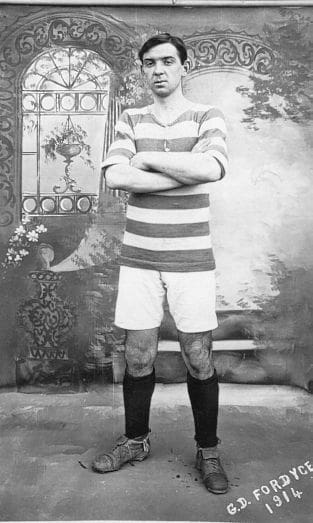Our supporter Nigel took on this year’s Frontline Walk in memory of LCpl William Angus, recipient of the Victoria Cross. This is his story.

Born in the small Scottish town of Carluke, William ‘Willie’ Angus became a local hero following his gallant exploits during World War One. Initially employed as a miner, Willie escaped the rigours of his mining work to join Glasgow Celtic as a professional footballer. However, his sporting career was soon interrupted by the outbreak of World War One.

A recruiting drive was held in Carluke by Sergeant Major George Caven of the famous Highland Light Infantry, where he addressed many of the town’s young men, encouraging them to join those fighting for King and Country. Willie Angus came forward as a recruit, as did James Martin – the young soldier with whom Willie’s fate would later be intertwined.
Both men underwent training in Dunoon, Scotland, with the Territorial Battalion of the Highland Light Infantry. Eager to put their skills to use right away, Willie and James volunteered for an attachment to the 8th Royal Scots and headed for the Western Front.
Finding themselves amidst the turmoil of trench warfare, the two soldiers were separated after Willie was shot in battle. Several weeks after he returned to the trenches, he learnt that following a covert bombing raid on the enemy embankment led by Lt James Martin, a large mine was secreted in the earth by the Germans, which created a vast hole in the embankment. This caused the party to retreat and discover some members were missing. Amongst them was Lt James Martin, who could later be seen across the embankment, barely conscious but still alive.
Upon hearing that the fellow Carluke man was in danger, Willie immediately volunteered to attempt a rescue. Whilst this was vetoed by senior officers, Angus’ plea was eventually approved. Counselled that he was facing certain death, Angus replied that it did not matter much whether death came now or later.
“…it does not matter much whether death came now or later.”
– Willie Angus
With a rope tied around him so he could be dragged back in the event of death or severe injury, Willie set off on his mission. He managed to reach James without being detected and his first selfless act was to remove his rope lifeline and tie it around the wounded Lieutenant, preparing for the dangerous return.
As they set off for the safety of the trench 70 yards away, they were spotted by the enemy who began to throw bombs over the parapet. Angus sheltered Lt Martin’s body from the shrapnel of the bombs and continued to lead him to safety, sustaining serious injuries along the way. Eventually, Martin recovered sufficiently for Angus to signal the troops to pull the officer in unaided, whilst Angus diverted enemy fire upon himself. At last, he reached the safety of the trenches and was rushed off to a medical station.
Tales of his self-sacrifice quickly swept the front and he was recommended for the Victoria Cross, with all those who witnessed the incident in no doubt that he would receive it.
William Angus returned to Britain on 30 August 1915, where he was presented with the Victoria Cross at Buckingham Palace. The King was particularly impressed by the incident and on hearing that Willie’s father was in the adjoining room, insisted that he be brought to join his son for the occasion. The King spoke with both men for a time far in excess of that allocated, and repeatedly expressed his admiration and appreciation of such bravery.

Frontline Walker Nigel discovered Willie’s incredible story through his late friend Jim McNulty, Willie’s nephew, and completed the 100km walk to honour his memory.
Today, we remember the selfless acts of gallantry and valour which LCpl William Angus displayed, as his determination drove him to leave no man behind even at the cost of his own life.


